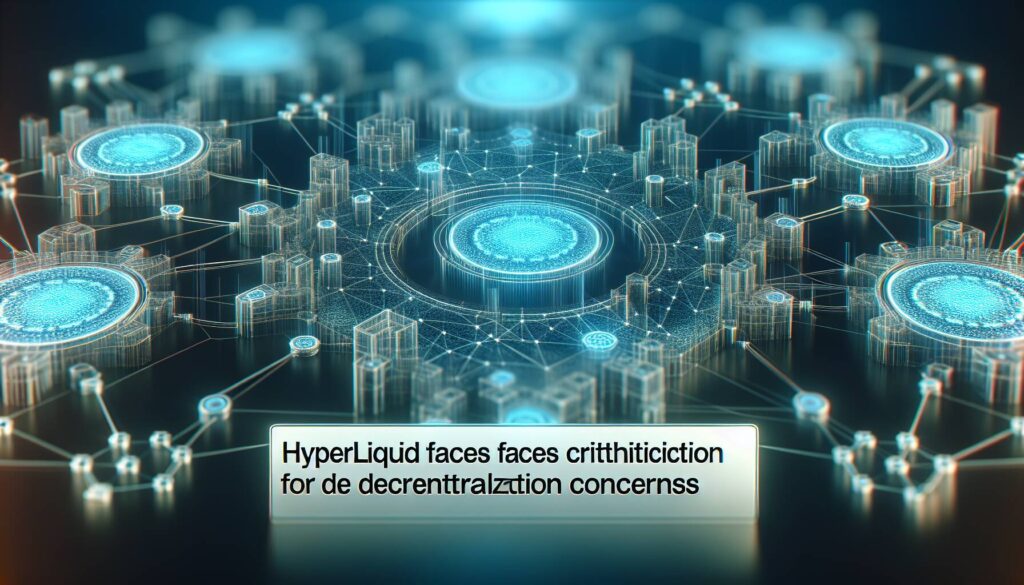HyperLiquid, a layer-1 blockchain platform renowned for its derivatives exchange, is currently in the spotlight following recent criticism regarding its level of decentralization and the operations of its validators. The concerns were raised by Kam Benbrik, an employee at ChorusOne, who highlighted issues tied to the platform’s use of “closed-source code.” This closed-source approach, he argues, effectively “jails” node operators and raises alarms over the concentration of control within the network.
At the heart of the matter is HyperLiquid’s substantial control over staked HYPE tokens, with a staggering 81% of the stake under its influence. Benbrik pointed out the potential risks associated with such centralization, emphasizing that if one entity were to control as little as one-third of the stake, they could potentially halt the blockchain. Should that figure escalate to two-thirds, the entity could wield complete control over the network—an alarming scenario for the community.
“If a single entity controls 1/3 of the stake, they can halt the chain. If they control 2/3 of the stake, they control the network entirely,” Benbrik stated.
Responding to these critiques, HyperLiquid took to X, announcing plans for a “Foundation Delegation Program” aimed at bolstering the performance of high-performing validators, which it hopes will address the concerns surrounding decentralization. On the topic of the closed-source code, HyperLiquid acknowledged the situation, stating that while the node code is currently not open source, such transparency is a priority, expected to be established once the software reaches a stable development state. The team maintains that the pace and scope of its development are notably faster compared to many other projects in the space.
The discourse surrounding HyperLiquid has sparked the emergence of negative sentiment towards the platform, a significant shift from the initial excitement following the launch of its native HYPE token, which experienced a meteoric rise from .57 to .5. However, in recent trading, HYPE has faced a downturn, currently sitting at .49 after a notable drop of 15.37% within the last 24 hours, as reported by CoinMarketCap.

HyperLiquid’s Response to Decentralization Concerns
HyperLiquid, a layer-1 blockchain recognized for its derivatives exchange, is currently facing scrutiny regarding its decentralization and validator issues. Here are the key points surrounding this situation:
- Criticism from Kam Benbrik:
- Benbrik, an employee at ChorusOne, highlighted concerns about HyperLiquid using “closed-source code.”
- Claims that the system “jails” node operators, leading to reduced decentralization.
- Control Over Staked HYPE:
- HyperLiquid holds 81% of the staked HYPE, increasing the potential for negative consequences.
- If a single entity controls:
- 1/3 of the stake – can halt the chain.
- 2/3 of the stake – can control the network entirely.
- Response to Decentralization Fears:
- Intention to launch a “Foundation Delegation Program” to promote high-performing validators.
- Aims to enhance decentralization moving forward.
- Closed-Source Code Justification:
- HyperLiquid stated that the node code is currently closed source, asserting that open sourcing is crucial but will occur only when development is stable.
- Claimed that their development pace is much faster than many projects, promising future open sourcing when security is guaranteed.
- Market Reaction:
- The initial phase post-launch saw HYPE token price surge from .57 to .5 due to high trading volumes.
- Following the criticisms, HYPE has experienced a downturn, recently trading at .49, reflecting a 15.37% drop within 24 hours.
Impact on Readers’ Lives:
Understanding these dynamics is crucial for investors and users of the HyperLiquid platform as it indicates the stability and reliability of the blockchain they are engaging with. Increased centralization may lead to potential risks for their investments and participation in the ecosystem.
HyperLiquid Faces Scrutiny Amidst Growing Decentralization Concerns
The unfolding story around HyperLiquid—a layer-1 blockchain platform—highlights competitive dynamics within the rapidly evolving crypto landscape. Their current predicament stems from reactions to Kam Benbrik’s criticism regarding the platform’s decentralization and validator management. While new projects are often celebrated for their innovation, HyperLiquid’s situation underscores potential vulnerabilities that can arise when systems are perceived as centralized.
One of HyperLiquid’s primary advantages is its efficient derivatives exchange, propelled by the unique technology underlying its network. However, this technological prowess comes with an inherent disadvantage: the clamor for transparency. Critics, including Benbrik, argue that the platform’s reliance on “closed-source code” appears to inhibit validator autonomy, relegating them to a subordinate role within the ecosystem. This aspect can alienate potential supporters and developers who prioritize decentralized frameworks when choosing which projects to engage with or invest in.
Moreover, with HyperLiquid controlling a staggering 81% of staked HYPE tokens, fears of single-entity dominance loom large. The implications of such concentrated control can extend beyond investor sentiment; they could ultimately hinder network trust and security. On the flip side, HyperLiquid’s establishment of a “Foundation Delegation Program” shows proactive steps toward promoting decentralization and could reassure stakeholders concerned about governance. This initiative could attract quality validators eager for participation in a more decentralized ecosystem.
However, these measures may not fully mitigate the backlash currently facing the platform. The shift from hype—post-launch trading volumes that catapulted HYPE’s value to .5—to a more cautious market sentiment reflects a re-evaluation by investors. Their recent losses, exemplified by a 15.37% drop to .49 in just 24 hours, signal that the trust that buoyed initial trading may be dwindling as fears about centralization take center stage.
This situation offers valuable lessons for other blockchain projects: an emphasis on transparency and decentralization is not just a regulatory checkbox but a vital component of maintaining community support and investor confidence. Projects that sidestep these principles may find themselves in similar predicaments, risking not only their reputations but also potential financial backing.
In particular, mid-tier blockchain companies contemplating ambitious projects must recognize this precarious balance. They could find themselves benefiting from understanding HyperLiquid’s missteps, especially in fostering a transparent environment. Conversely, existing, well-established platforms that prioritize decentralization should position themselves as safer alternatives, leveraging HyperLiquid’s struggles to promote their own models. The crypto realm is relentless, and the lessons learned from HyperLiquid’s current challenges will likely resonate across the industry, shaping future endeavors in technology and governance.

















